When your vision suddenly goes blurry or dark in one eye-without pain, without warning-it’s not just a bad day. It could be retinal vein occlusion (RVO). This isn’t a rare glitch. Around 16 million people worldwide live with it. And for many, the only thing standing between them and permanent vision loss is a tiny injection in the eye.
What Exactly Is Retinal Vein Occlusion?
Your retina is like the film in a camera. It catches light and turns it into signals your brain understands as images. Behind it, a network of veins drains blood away. When one of these veins gets blocked, blood and fluid leak into the retina. That’s RVO. There are two main types:- Central Retinal Vein Occlusion (CRVO): The main vein behind the eye is blocked. This usually causes more severe vision loss.
- Branch Retinal Vein Occlusion (BRVO): A smaller branch is blocked, often where a hard artery presses down on the vein. Vision loss is usually partial, affecting one part of your sight.
Neither type is caused by trauma. It’s not something you bump into. It’s a slow-burning problem-years of high blood pressure, aging arteries, or hidden blood disorders finally catching up.
Who’s at Risk? The Real Culprits Behind RVO
You can’t control your age. But you can understand what’s pushing you toward RVO.Over 90% of CRVO cases happen after age 55. Half of all RVO cases are in people over 65. But don’t think you’re safe just because you’re young. About 1 in 10 cases strike people under 45.
Here’s what actually drives the blockage:
- Hypertension: High blood pressure is the #1 risk factor. Up to 73% of CRVO patients over 50 have it. Even if you think your blood pressure is "okay," uncontrolled numbers silently damage the tiny vessels in your eye.
- Diabetes: About 10% of RVO patients over 50 have diabetes. It doesn’t just affect your feet or kidneys-it weakens blood vessels everywhere, including the retina.
- High cholesterol: Total cholesterol above 6.5 mmol/L is linked to 35% of RVO cases. That’s not just "bad diet"-it’s hardening of the arteries, and your eye veins are among the first to suffer.
- Glaucoma: High pressure inside the eye doesn’t just hurt your optic nerve. It can squeeze the retinal vein right at the point where it exits the eye.
- Smoking: Around 25-30% of RVO patients smoke. It thickens blood, damages vessel walls, and speeds up atherosclerosis.
- Oral contraceptives: For women under 45, this is one of the most common triggers for CRVO. If you’re young and suddenly lose vision, doctors will ask about birth control.
- Blood disorders: Conditions like polycythemia, multiple myeloma, or inherited clotting disorders (like Factor V Leiden) make blood sticky. That’s a recipe for blockage.
Obesity and sitting too much? They don’t directly cause RVO-but they feed the fire. They worsen blood pressure, cholesterol, and insulin resistance. It’s not one thing. It’s the combo.
The Injections That Save Sight
The blockage itself can’t be undone. But the damage it causes-fluid leaking into the macula, the center of your vision-can be stopped. That’s where injections come in.For decades, there was no treatment. Now, three main drugs are injected directly into the eye:
- Anti-VEGF drugs: Ranibizumab (Lucentis), aflibercept (Eylea), and off-label bevacizumab (Avastin). These block a protein called VEGF that makes blood vessels leak.
- Corticosteroids: Dexamethasone implant (Ozurdex). Reduces swelling and inflammation.
Here’s what the data shows:
- In the BRAVO trial, patients on ranibizumab gained an average of 16.6 letters on the eye chart after a year. The placebo group gained just 7.4.
- Aflibercept improved vision by 18.3 letters in the COPERNICUS trial.
- Ozurdex helped 27.7% of CRVO patients gain 15+ letters of vision-double the sham group.
Most people start with monthly injections. After a few months, if the swelling goes down, doctors switch to "as needed"-checking every 4-8 weeks with an OCT scan. Real-world data shows patients need 8-12 injections per year to keep vision stable.
Bevacizumab (Avastin) is used off-label because it costs about $50 per shot, while Lucentis and Eylea cost nearly $2,000. In public hospitals, 60-70% of RVO injections are Avastin. In private clinics, it’s closer to 30%. The results? Just as good.

What the Injections Actually Feel Like
The procedure takes less than 10 minutes. You’re awake. Your eye is numbed with drops. A tiny needle goes in-no stitches, no cutting.Common side effects:
- Red spot on the white of your eye (subconjunctival hemorrhage)-happens in 1 in 3 people. Looks scary, but it’s harmless and fades in days.
- Floaters-tiny dots or lines you see for a few hours. Normal.
- Temporary pressure spike in the eye-rarely needs treatment.
Serious problems? Endophthalmitis (infection inside the eye) is extremely rare-0.02% to 0.1% of injections. That’s less than 1 in 1,000.
But the real challenge isn’t the needle. It’s the schedule.
One patient on a support forum said: "I’ve had 18 monthly injections. My vision improved. But the anxiety before each one? I now skip appointments because I can’t face it."
Another said: "I tried 8 Avastin shots with no change. Then I got the Ozurdex implant. Ten lines of vision back in two weeks. Worth every penny."
Cost matters. $150 per injection adds up fast. Insurance helps-but not always enough. That’s why many patients switch between drugs based on price, response, and tolerance.
Why One Size Doesn’t Fit All
Doctors don’t just pick a drug and go. They tailor it.Dr. Rosa Dolz-Marco, a retina specialist in Spain, says: "If your vision is worse than 20/200 at diagnosis, start with the steroid implant. If it’s better than 20/40, go with anti-VEGF."
Dr. Carl Awh, a U.S. retina expert, warns: "Steroids can cause cataracts in 60-70% of patients who still have their natural lens. And 30% get high eye pressure that needs medication. Anti-VEGF is safer long-term, even if you need more shots."
So if you’re young, have good baseline vision, and want to avoid cataracts? Anti-VEGF is likely your best bet. If you’re older, have severe vision loss, and can’t handle monthly visits? The implant might be better-even if it costs more.
Combination therapy is now being tested: anti-VEGF first, then a steroid if it stalls. Early results show better outcomes for stubborn cases.
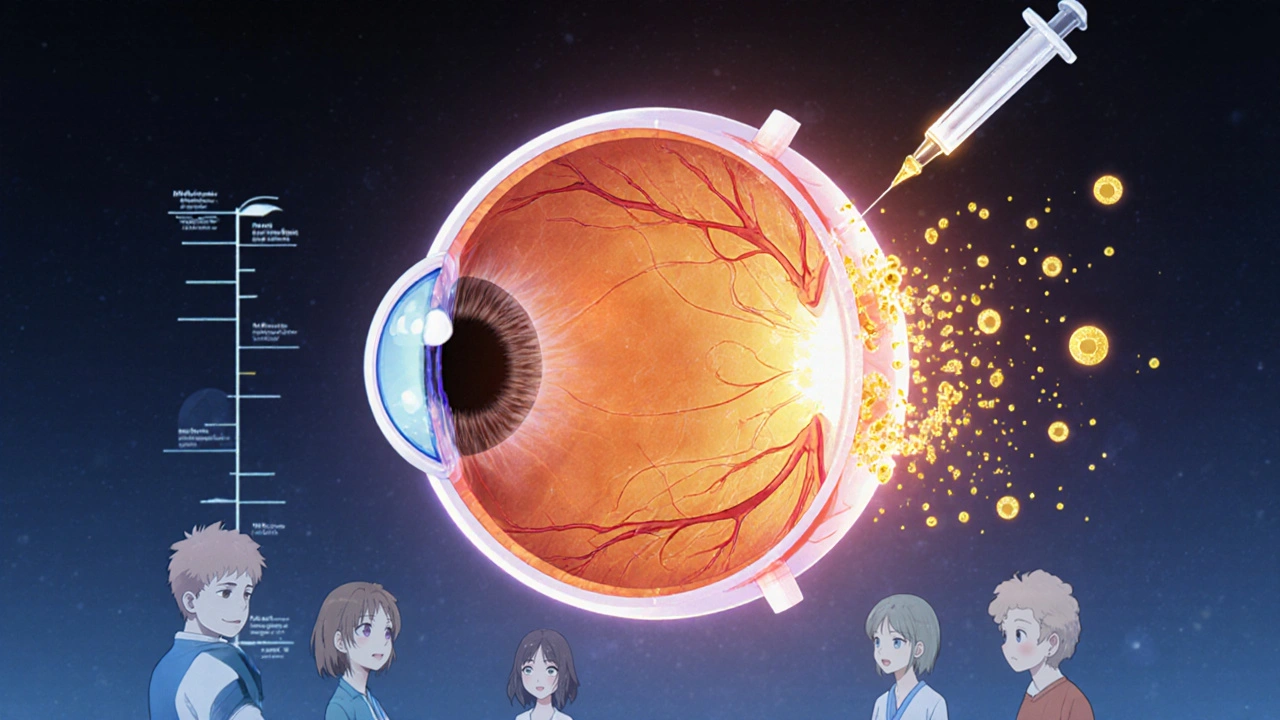
What’s Next? The Future of RVO Treatment
The days of monthly shots may be ending.The COMINO study found that a "treat-and-extend" approach-starting monthly, then slowly stretching the time between injections-works just as well, with 30% fewer shots.
And new tools are coming:
- Susvimo: A tiny pump implanted in the eye that slowly releases ranibizumab. Approved for macular degeneration, now being tested for RVO. Could mean quarterly, not monthly, injections.
- Gene therapy (RGX-314): A one-time injection that makes your eye produce its own anti-VEGF protein. Phase II trials are underway.
- OPT-302: A new drug that blocks a different VEGF protein. Used with Eylea, it’s showing promise for patients who don’t respond to standard therapy.
Doctors are also using OCT angiography-a detailed scan of the eye’s blood flow-to predict who will respond to treatment. This isn’t science fiction. It’s happening now.
What You Can Do Right Now
If you’ve been diagnosed with RVO:- Stick with the treatment plan. Vision doesn’t improve overnight. It takes months.
- Control your blood pressure. Even if you’re on meds, check it at home weekly.
- Get your cholesterol and blood sugar tested. If they’re high, treat them like your vision depends on it-because it does.
- Quit smoking. It’s the single biggest lifestyle change you can make.
- Ask about cost-saving options. Bevacizumab is just as effective as the expensive brands.
- Don’t skip follow-ups. OCT scans are your best friend. They tell your doctor when to inject-and when to stop.
If you’re over 50 and haven’t had an eye exam in a year? Get one. RVO often has no early symptoms. By the time you notice vision loss, it’s already advanced.
There’s no cure. But with the right treatment, most people keep functional vision. Many go back to driving, reading, and recognizing faces. It’s not perfect. But it’s enough.
Can retinal vein occlusion be reversed?
The blockage itself cannot be reversed. But the swelling and fluid buildup it causes-macular edema-can be treated with injections. Many patients regain significant vision, especially if treatment starts early. Without treatment, vision loss is often permanent.
Are retinal injections painful?
No. The eye is numbed with drops, so you’ll feel pressure, not pain. The procedure takes under 10 minutes. Some people feel a brief sting or see floaters afterward, but these fade quickly. The fear of the shot is often worse than the shot itself.
How many injections do I need for RVO?
Most patients start with monthly injections for 3-6 months. After that, treatment switches to "as needed," based on OCT scans showing fluid levels. On average, people need 8-12 injections per year. Newer protocols like treat-and-extend can reduce that by 30%.
Can I use Avastin instead of Lucentis or Eylea?
Yes. Avastin (bevacizumab) is not FDA-approved for eye use, but it’s widely used and proven just as effective as Lucentis and Eylea in multiple studies. It costs about $50 per shot versus $2,000. Many safety-net clinics use it as the first-line option. Your doctor can explain if it’s right for you.
Will I go blind from RVO?
Not if you get treated. Without treatment, severe vision loss is common. With timely injections, 30-40% of patients regain 20/40 vision or better-the legal standard for driving in most places. The key is early diagnosis and sticking with treatment. Many people keep good vision for years.
Can lifestyle changes help with RVO?
Absolutely. Controlling blood pressure, cholesterol, and blood sugar is critical. Quitting smoking cuts your risk of recurrence. Regular exercise improves circulation. While these won’t undo the blockage, they prevent new ones from forming and make treatments work better.
Is RVO linked to stroke or heart disease?
Yes. RVO is a sign that blood vessels throughout your body are damaged. People with RVO have a higher risk of stroke and heart attack in the next 5 years. Your eye doctor will likely refer you to your GP for a full cardiovascular check-up.
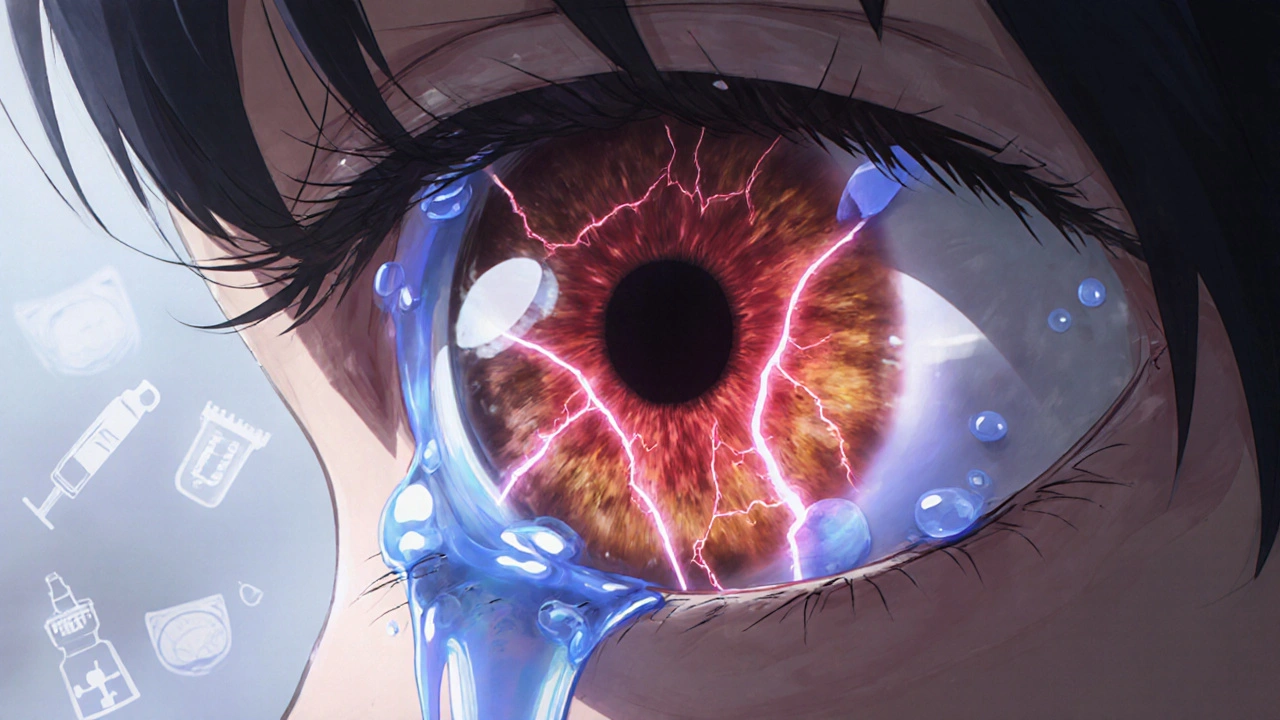
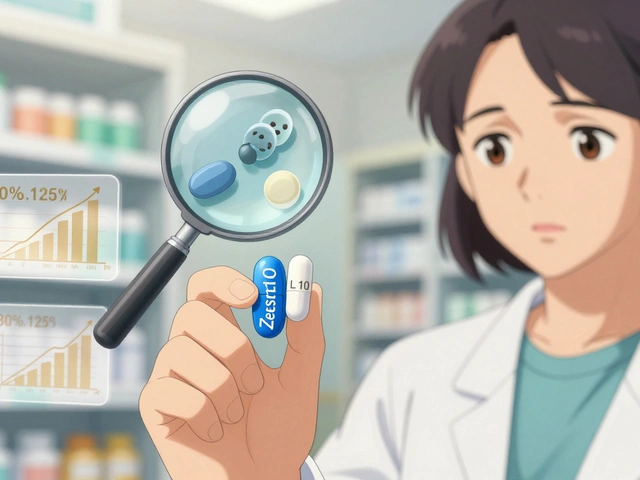
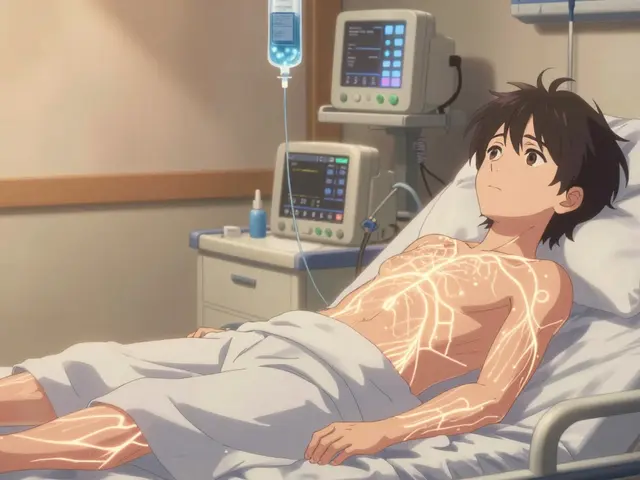
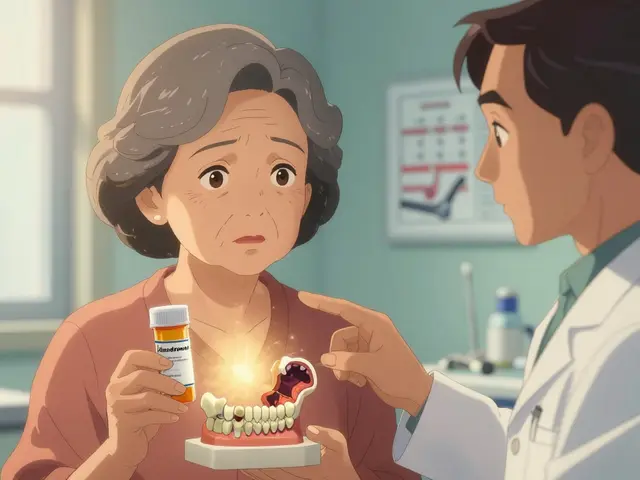
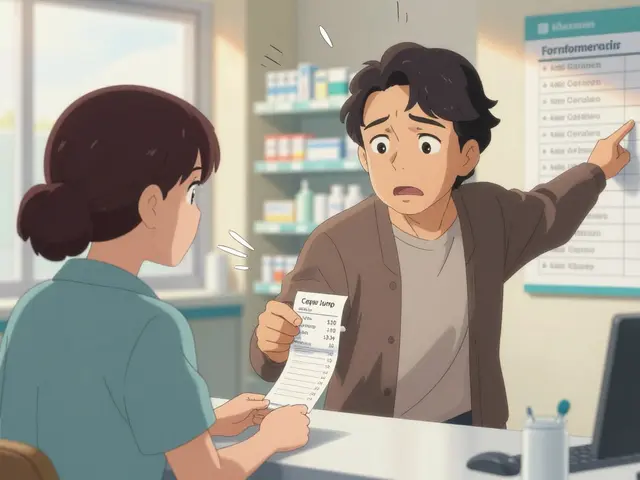
Amie Wilde
November 11, 2025 AT 09:46Just had my 12th injection last week. Still see floaters, but I can read my grandkids’ texts again. Worth every second of anxiety.
Gary Hattis
November 12, 2025 AT 23:47Been in the U.S. healthcare system long enough to know: if a drug costs $2000 and another does the same thing for $50, you’re not being treated-you’re being exploited. Avastin isn’t a loophole, it’s a damn necessity. My dad got his vision back with it. No regrets.
Esperanza Decor
November 14, 2025 AT 03:30I’m 48 and got BRVO after my third pregnancy. No history of hypertension, no diabetes, no smoking-just a weird clotting gene they found after the fact. If you’re under 50 and this happens to you, push for blood work. Don’t let them brush it off as "just aging." It’s not.
Also, the Ozurdex implant? Life-changing. No more monthly dread. Just a quick in-and-out every 4 months. My doctor said it’s not for everyone, but for me? Perfect.
Deepa Lakshminarasimhan
November 14, 2025 AT 19:46They say it’s about blood pressure and cholesterol… but have you ever looked at the ingredients in those eye injections? Ever wonder why Big Pharma doesn’t want you to know about natural anti-inflammatories? Turmeric, omega-3s, garlic-these have been used for centuries. The system doesn’t profit from herbs, so they push needles. I’m not saying avoid treatment, but don’t ignore what’s been hiding in plain sight.
Erica Cruz
November 14, 2025 AT 22:46Let’s be real-this whole post reads like a pharma pamphlet. Anti-VEGF drugs? Sure, they work. But the long-term effects? Barely studied. And those "clinical trials"? Funded by the same companies selling the drugs. I’ve seen patients go blind after years of injections because their retinas just… stopped responding. This isn’t medicine. It’s a revenue stream with a side of hope.
Johnson Abraham
November 16, 2025 AT 10:41avastin = 50 bucks. lucentis = 2k. smh. why do people even pay for the fancy one? 🤡 my cousin got 14 shots with avastin and now he sees his dog again. no cap. also, quit smoking. duh.
Shante Ajadeen
November 18, 2025 AT 09:18Just want to say thank you to whoever wrote this. I’ve been scared to go to the retina specialist for months. This broke it down without making me feel dumb. I’m scheduling my OCT scan tomorrow. You’re right-early detection matters. And yes, I’m quitting smoking. Starting Monday.
Danae Miley
November 19, 2025 AT 08:36Correction: The BRAVO trial showed a mean gain of 16.6 letters, not "16.6 letters on the eye chart"-the ETDRS chart is standardized. Also, the COPERNICUS trial used aflibercept in CRVO, not BRVO; the paper specifies that. Precision matters when discussing clinical outcomes.
Amie Wilde
November 20, 2025 AT 13:11^ I had that same thought when I read "eye chart." But honestly? I didn’t care about the chart name-I just cared that I could see my cat again. Numbers don’t change how you feel when you finally read a billboard from the car.